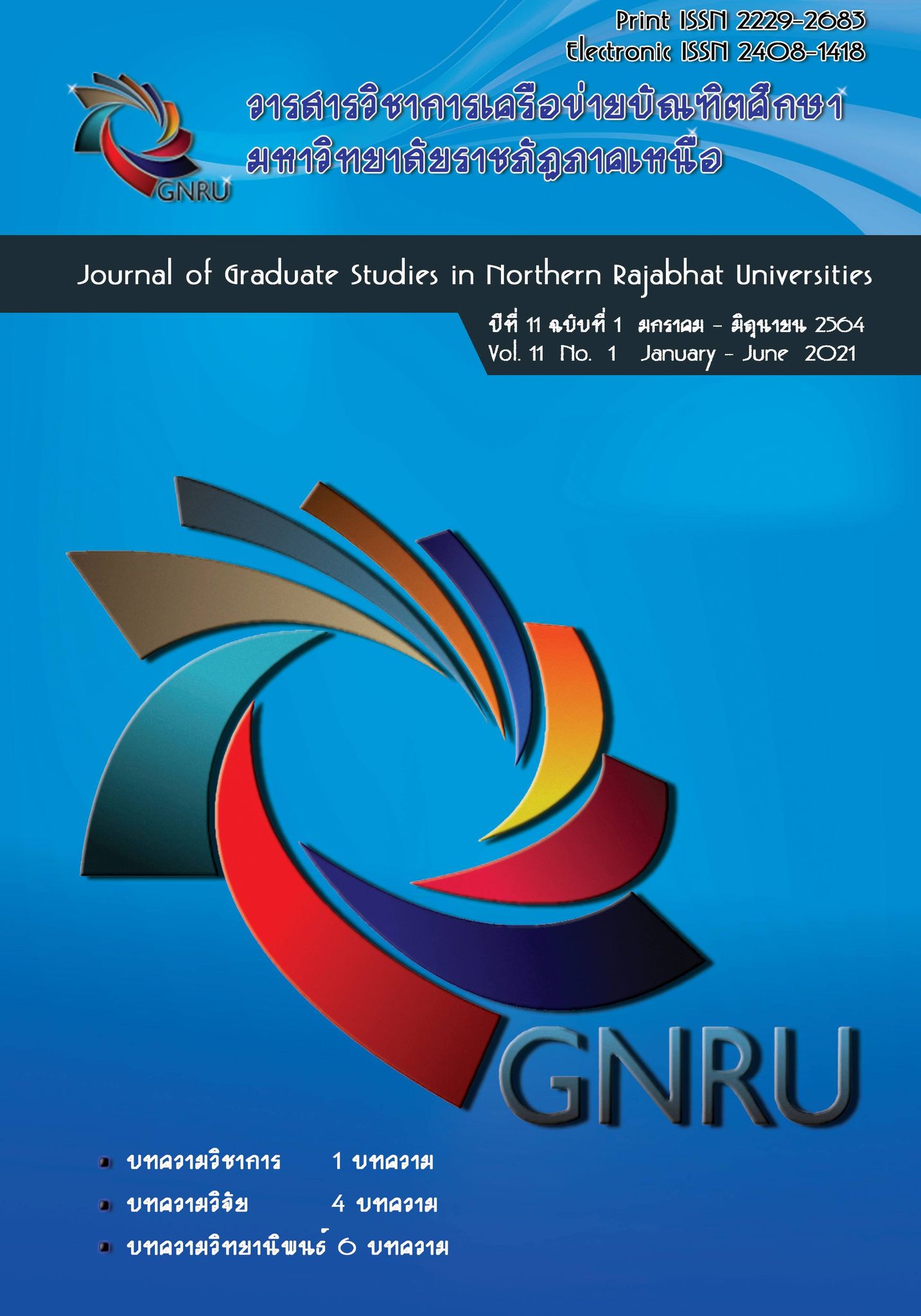แนวคิดเชิงคำนวณร่วมกับรูปแบบการเรียนรู้ Coding เพื่อส่งเสริมทักษะการแก้ปัญหาแบบร่วมมือ Computational concept is combined with the coding learning management model to enhance Collaborative problem-solving skills
Main Article Content
Abstract
แนวคิดเชิงคำนวณเป็นกระบวนการคิดที่เป็นระบบ คิดวิเคราะห์ คิดอย่างมีเหตุผลเพื่อการแก้ปัญหาในชีวิตประจำวัน ซึ่งครูผู้สอนต้องปลูกฝังแนวคิดเชิงคำนวณให้เกิดขึ้นในตัวของผู้เรียนตั้งแต่ระดับชั้นประถมศึกษาจนกระทั่งถึงระดับมหาวิทยาลัย ที่มีจุดเน้นสำคัญสำหรับการฝึกใช้แนวคิดเชิงคำนวณเพื่อการวิเคราะห์รายละเอียดของปัญหาในสถานการจริง ลักษณะที่เป็นนามธรรม และถ้าหากผู้สอนต้องการให้ผู้เรียนเกิดทักษะการเรียนรู้ในศตวรรษที่ 21 หรือที่เรียกกันว่า “Learning by doing” การเรียนรู้จะเกิดขึ้นได้ต้องลงมือทำด้วยตนเองเท่านั้น ผู้สอนจะต้องสร้างการเรียนรู้ในสิ่งที่เป็นรูปธรรมผ่านการ Coding จึงเป็นเหตุผลสำคัญที่ครูผู้สอนต้องออกแบบการจัดกิจกรรมการเรียนการสอนแนวคิดเชิงคำนวณร่วมกับรูปแบบการเรียนรู้ Coding ให้กับผู้เรียนได้ฝึกคิดและฝึกปฏิบัติในสถานการณ์จริงหรือสถานการณ์ที่ใกล้เคียงในลักษณะแบ่งกลุ่มการเรียนรู้เพื่อแก้ปัญหา ซึ่งจะส่งผลให้ผู้เรียนเกิดทักษะการแก้ปัญหาแบบร่วมมือ ทั้งนี้ครูผู้สอนควรจะได้รับการฝึกอบรมแนวคิดเชิงคำนวณ และรูปแบบการเรียนรู้ Coding ก่อนที่จะนำไปจัดกิจกรรมการเรียนการสอนในชั้นเรียน ผลลัพธ์ที่ได้จากการใช้แนวคิดเชิงคำนวณร่วมกับรูปแบบการเรียนรู้ Coding จะนำไปสู่การสร้างสิ่งประดิษฐ์ใหม่ๆ เพื่อแก้ปัญหาได้อย่างสร้างสรรค์ด้วยการใช้เทคโนโลยี และสามารถนำไปใช้จริงในชีวิตประจำวันได้อย่างสมเหตุสมผล สะดวกและรวดเร็ว
Computational concept is the critical and systematic thinking of solving problems in daily life. The teachers must cultivate computational concepts for the students from the beginning when they are in primary school until their university years. An important focus for the practice of using computational concepts is for detailed analysis of problems in real life situations. If the teacher wants the students to learn skills in the 21st century using “Learning by doing” method, the teacher must create concrete learning through coding. It is therefore important for the teachers to design teaching and learning the computational concepts together with the Coding Learning Model. This will help the students to organize their thinking process and practice it in either the visualized or real life situations. It can assist the students to develop cooperative problem-solving skills. For this purpose, the teachers should be trained in computational concepts and the “Coding Learning Management” before organizing classroom activities. The results of using computational concepts combined with the “Coding Learning Management” will lead to the creation of new inventions and can be used in daily life.
Article Details
References
กระทรวงศึกษาธิการ. (2558). ชุดฝึกอบรมการยกระดับคุณภาพของผู้เรียนสู่ความพร้อมในการประเมินระดับนานาชาติ. กรุงเทพฯ: สำนักงานวิชาการและมาตรฐานการศึกษา.
กระทรวงศึกษาธิการ. (2542). พระราชบัญญัติการศึกษาแห่งชาติ พุทธศักราช 2542. กรุงเทพฯ: พริกหวานกราฟฟิค.
กระทรวงศึกษาธิการ. (2563). ประกาศกระทรวงศึกษาธิการ เรื่อง นโยบายและจุดเน้นของ กระทรวงศึกษาธิการปีงบประมาณพุทธศักราช 2563. กรุงเทพฯ: กระทรวงศึกษาธิการ.
ขวัญชัย ขัวนาและธารทิพย์ ขัวนา. (2562). การจัดการเรียนการสอนเพื่อส่งเสริมทักษะการเรียนรู้ในศตวรรษที่ 21. วารสารบัณฑิตศึกษามหาวิทยาลัยราชภัฏสกลนคร,16(73),13-22.
กัลยา โสภณพนิช, คุณหญิง. (2562). ความหมายของการ Coding. สืบค้นเมื่อวันที่ 14 กุมภาพันธ์ 2563, จาก https://thepotential.org/2019/10/07/coding-in-school-scoop.
เขมวดี พงศานนท์. (2562). CODING คืออะไร. สืบค้นเมื่อวันที่ 14 กุมภาพันธ์ 2563, จาก https://thepotential.org/2019/10/07/coding-in-school-scoop.
ชยการ คีรีรัตน์.(2562). การใช้กระบวนการแก้ปัญหาและโปรแกรม App Inventor พัฒนาทักษะการคิดเชิงคำนวณ (Computational Thinking: CT) สำหรับผู้เรียนระดับมัธยมศึกษา. วารสารครุศาสตร์จุฬาลงกรณ์มหาวิทยาลัย, 47(2), 31-47.
ธีรฎา ไชยเดชและคณะ. (2560). การพัฒนาสมรรถนะการแก้ปัญหาแบบร่วมมือด้วยการจัดการเรียนรู้โดยใช้วิจัยเป็นฐานตามแนวคิดสะเต็มศึกษาเรื่องเชื้อเพลิงซากดึกดำบรรพ์และผลิตภัณฑ์. วารสารหน่วยวิจัยวิทยาศาสตร์เทคโนโลยีและสิ่งแวดล้อมเพื่อการเรียนรู้, 8(1), 51-66.
ปฏิภาณ ลือนาม. (2560). การพัฒนาทักษะการคิดแก้ปัญหาและการทำงานเป็นทีมด้วยรูปแบบการเรียนรู้แบบร่วมมือโดยใช้เทคนิคทีเคโอสำหรับห้องเรียนพิเศษวิทยาศาสตร์ชั้น มัธยมศึกษาปีที่ 5 วิทยานิพนธ์ปริญญามหาบัณฑิต, มหาวิทยาลัยราชภัฏมหาสารคาม.
พิมณิชา ทวีบทและคณะ. (2559). การพัฒนาสมรรถนะการแก้ปัญหาแบบร่วมมือของนักเรียนห้องเรียนพิเศษวิทยาศาสตร์ เรื่อง ปริมาณสารสัมพันธ์โดยการจัดการเรียนรู้ด้วยรูปแบบการแก้ปัญหาอย่างสร้างสรรค์. นเรศวรวิจัย(13), วิจัยและนวัตกรรมขับเคลื่อนเศรษฐกิจ และสังคม, 937-948.
ภาสกร เรืองรอง, รุจโรจน์ แก้วอุไร, ศศิธร นาม่วงอ่อน, อพัชชา ช้างขวัญยืน และศุภสิทธิ์ เต็งคิว (2561). Computational Thinking กับการศึกษาไทย. วารสารปัญญาวิวัฒน์, 10(3), 322-330.
สถาบันส่งเสริมการสอนวิทยาศาสตร์และเทคโนโลยี. กระบวนการแก้ปัญหา FOCUS ประเด็นจาก PISA. สืบค้นเมื่อวันที่ 14 กุมภาพันธ์ 2563, จาก www.ipst.ac.th.
วิจารณ์ พานิช. (2556). การสร้างการเรียนรู้สู่ศตวรรษที่ 21. กรุงเทพฯ : มูลนิธิสยามกัมมาจล.
สถาบันส่งเสริมการสอนวิทยาศาสตร์และเทคโนโลยี. (2563). สมรรถนะของวิทยาการคำนวณเข้ากับสมรรถนะPISA. กิจกรรมหลักสูตรอบรมวิทยากรท้องถิ่นในเรื่องวิทยาการคำนวณหลักสูตรเพิ่มศักยภาพครูให้มีสมรรถนะของครูยุคใหม่สำหรับการเรียนรู้ในศตวรรษ ที่ 21.
Adidah Lajis, Haidawati Md Nasir & Normaziah A. (2018). Proposed Assessment Framework Based on Bloom Taxonomy Cognitive Competency: Introduction to Programming. Association for Computing Machinery, ACM ISBN 978-1-4503-5414-1/18/02.
Buitrago Flórez, F., Casallas, R., Hernández, M., Reyes, A., Restrepo, S. & Danies, G. (2017). Changing a Generation’s Way of Thinking: Teaching Computational Thinking Through Programming, 87(4), 834–860.
Cynthia C. Selby. Relationships: computational thinking, pedagogy of programming and Bloom’s Taxonomy. ACM 978-1-4503-3753-3/15/11.
García-Pe~nalvo, F. J., & Mendes, A. J., (2017). Exploring the computational thinking effects in pre-university education, Computers in Human Behavior.
Jeannette M. Wing. (2012). Computational thinking. Microsoft Research Asia Faculty.
Joohi Lee & Jo Junoh . (2019). Implementing Unplugged Coding Activities in Early Childhood Classrooms. Early Childhood Education Journal (2019) 47: 709–716. Published online:19 August 2019. Springer Nature B.V. 2019, corrected publication 2019.
Longkai Wu & Chee-Kit Looi & Jari Multisilta & Meng-Leong How & Hyungshin Choi & Ting-Chia Hsu & Pauliina Tuomi. (2019). Teacher’s Perceptions & Readiness to Teach Coding Skills: A Comparative Study Between Finland, Mainland China, Singapore, Taiwan and South Koreag.
Pauliina Tuomi & Jari Multisilta & Petri Saarikoski & Jaakko Suominen. (2017). Coding skills as a success factor for a society.
Robert E. Cummings (2006). Coding with power: Toward a rhetoric of computer coding and composition. Computers and Composition 23, (2006), 430–443.
Shenghua Zha &Yi Jin & Pamela Moore & Joe Gaston. (2019). Hopscotch into Coding: Introducing Pre-Service Teachers. Tech Trends (2020), 64: 17-28.
Ting-Chia Hsu & Shao-Chen Chang & Yu-Ting Hung. (2018). How to learn and how to teach computational thinking: Suggestions based on a review of the literature. Received in revised form 29 June 2018; Accepted 2 July 2018.
Ugur Kale & Mete Akcaoglu & Theresa Cullen & Debbie Goh & Leah Devine & Nathan Calvert & Kara Grise. (2018). Computational What? Relating Computational Thinking to Teaching. Association for Educational Communications & Technology 2018.


